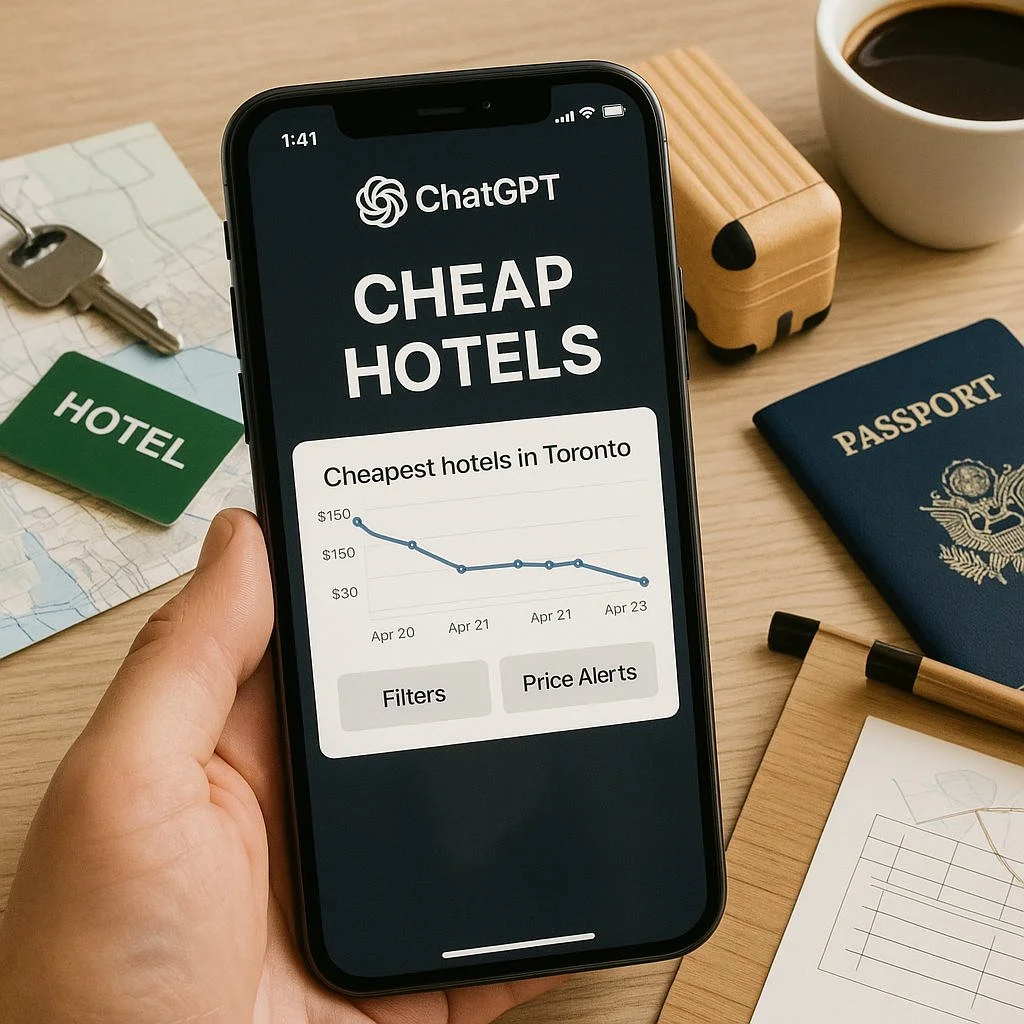How to Use ChatGPT to Find Cheap Hotels
ChatGPT won’t book rooms for you, but it can engineer the search so you end up with a cheaper total price for a room that actually fits your needs. Treat it like a strategy layer:
Define your must-haves, nice-to-haves, and absolute dealbreakers.
Flex: dates, neighborhoods, room types, cancellation terms.
Compare apples to apples: total price (taxes, resort fees, parking, Wi-Fi).
Stack savings: loyalty status, credit-card perks, bundles, price-drop rebooking.
Sanity-check quality and safety without getting duped by photos.
Negotiate when timing is on your side (direct, same-day, shoulder season).
Everything below gives you prompts, templates, and a repeatable workflow.
Step 1 — Build a sharp “trip profile” before you search
Prompt: Trip Profile Builder
“I’m looking for a hotel in [city/region] from [date] to [date]. Budget per night before taxes: [$]; total trip budget: [$]. Guests: [#]; beds: [1 king / 2 doubles / etc.]. Must-haves: [private bathroom, AC, elevator, desk, fridge]. Nice-to-haves: [pool, gym, late checkout]. Dealbreakers: [shared bath, resort fee, no windows]. Accessibility: [step-free, roll-in shower]. Safety: [24/7 front desk, safe neighborhood]. Noise tolerance: [low/medium/high]. Ask me 5 clarifying questions, then summarize my search criteria as bullets.”
This gives you a reusable spec that prevents “cheap but wrong.”
Step 2 — Use flexibility to lower price (time and place)
What moves price the most
Day of week: Sun–Thu often cheaper than Fri–Sat in business cities (inverse for resort towns).
Seasonality: shoulder seasons beat holidays and events.
Neighborhood micro-shifts: 10–20 minutes away = big savings.
Room type: “standard” with two beds sometimes cheaper than a king.
Cancellation terms: non-refundable is cheaper—but only if your dates are firm.
Prompt: Flex Grid
“Create a flexible date grid for [city] around [target dates]: shift ±3 days and show expected price direction by weekday. Add a second grid for three nearby neighborhoods with pros/cons (safety, transit, food, late-night noise). Recommend the cheapest acceptable combo.”
Step 3 — Compare total price, not nightly rate
Low nightly rates often hide fees. Always add:
Taxes & local fees
Resort/destination fees
Parking (overnight)
Wi-Fi (if not included)
Breakfast (if you’d otherwise buy it)
Extra adult/rollaway fees
Pet fees (if applicable)
Late checkout (if you need it)
Prompt: True Cost Calculator
“For this shortlist [paste options with base rates and known fees], compute the total stay cost: base × nights + taxes/fees + parking + Wi-Fi + breakfast [yes/no] + expected incidentals [$ estimate]. Rank cheapest to most expensive and flag anything with bad cancellation terms.”
Step 4 — Choose cancellation strategy (and why it changes price)
Fully refundable costs more but lets you re-book if the price drops.
Non-refundable is cheaper but risky; use only with date certainty.
Semi-flex windows (e.g., free cancellation until 48–72 hours prior) can be the sweet spot.
Prompt: Refundability Planner
“Given my risk tolerance [low/med/high], propose a cancellation strategy. If I book a refundable rate today, outline a weekly ‘re-price’ routine to check for price drops and when to switch to a non-refundable rate.”
Step 5 — Neighborhood and safety sanity check
Photos lie. Check context, not just interiors.
What to evaluate
Block-level vibe at night vs day
Proximity to noisy venues or highways
Late-night transit availability or rideshare costs
Lighting, foot traffic, and 24/7 desk
Prompt: Neighborhood Fit Test
“Describe [neighborhood] by day and by night for a visitor: safety cues, noise sources, late-night food, transit after 10pm, typical travel time to [landmarks/meetings] at rush hour vs off-peak. Suggest two backup areas with similar vibe but better value.”
Step 6 — Stack savings (the compounding effect)
Levers you can combine
Loyalty: even base status may include late checkout or small discounts.
Credit-card perks: annual statement credits, 4th-night-free benefits, or rate guarantees.
Bundles: flight + hotel packages can undercut standalone prices (check total).
Corporate/association codes: employer, alumni, membership groups.
Length-of-stay: weekly or 3-night promos.
New-property promos: soft-opening periods can be cheaper.
Price-drop rebooking: hold refundable, then switch when cheaper.
Prompt: Stacking Strategy
“Given these assets [loyalty status, credit card benefits, memberships, flexibility], build a stacking plan: which lever to use first, what to verify in fine print, and a decision rule for when a bundle beats standalone.”
Step 7 — Shortlist construction (2–4 high-probability options)
What belongs in your shortlist
Clear total price
Cancellation policy and deadline
Room type and bed count
Distance/time to primary destinations
Quality markers (recent renovation, soundproofing, solid housekeeping, working AC/heat)
Dealbreakers absence confirmed
Prompt: Shortlist Builder
“Turn my criteria into a 4-slot shortlist template: hotel/name placeholder, neighborhood, total cost, cancellation deadline, room/bed type, travel time to [place], pros/cons (3 each), and a confidence score. Leave a notes column for price-drop checks.”
Step 8 — Quality control: filter hype and spot red flags
Red flags to watch
Overly staged photos with no raw shots of bathrooms or windows
“Cozy” rooms with no square footage listed
Many reviews mentioning noise, musty smell, broken AC, or thin walls
“No front desk” when you need late check-in help
Surprise deposits or ID rules not disclosed up front
Prompt: Red-Flag Scanner
“Based on common hotel pitfalls, generate a yes/no checklist to evaluate listings: room size disclosed, real window, recent reviews mention [AC/noise/cleanliness], 24/7 desk, elevator, strong door locks, predictable fees. Add a score out of 10.”
Step 9 — Same-day and last-minute plays (when they’re cheapest)
Business cities (Mon–Thu): best same-day deals after 4–6 pm when unsold inventory gets discounted.
Leisure markets (Fri–Sun): earlier planning beats walk-in.
Weather-dependent destinations: soft demand on rainy or very hot/cold days may cut rates.
Direct call tactic: polite, concise call asking for the best available rate for tonight, referencing a comparable price you’re seeing elsewhere.
Prompt: Same-Day Script
“Write a 30-second phone script to call hotels directly: confirm availability for [tonight/tomorrow], ask for best available rate, mention I’m choosing between [two properties], and request a price consideration or perk (parking, breakfast, late checkout). Keep it friendly and brief.”
Step 10 — Book smarter: room placement and noise control
Ask for a high floor, end of corridor, away from elevators/ice machines.
Avoid rooms facing busy roads, clubs, or loading bays.
If light sleep: pack earplugs, request foam pillows, bring a white-noise app.
Prompt: Room Request Note
“Draft a polite room request note for [reservation name/dates]: high floor, away from elevator and ice machines, quiet side, foam pillows if available, and confirmation of late check-in.”
Step 11 — After booking: re-price, re-shop, and protect
Calendar the cancellation deadline and set a 48-hour reminder.
Weekly price check on your refundable booking; if lower, rebook then cancel the original.
Watch for construction notices or amenity closures—use them to negotiate a reduction or cancel penalty-free.
Keep screenshots of your final total to challenge billing errors.
Prompt: Re-Price Routine
“Create a re-price schedule for my refundable booking: check [days/times], decision rules for what drop is ‘worth it’ after taxes/fees, and a step-by-step to rebook safely without double charging.”
Step 12 — Special situations
Families / groups
Two connecting rooms may beat one suite on cost.
Breakfast included can offset higher nightly rate.
Prompt:
“Compare value of 2 connecting rooms vs 1 suite for [# people]: show total cost, bed count, bathrooms, and morning logistics (getting kids ready).”
Solo business trips
Walkable to meetings saves rideshare costs; late checkout valuable on departure day.
Quiet rooms matter more than amenities.
Prompt:
“Optimize for productivity and sleep near [address]: prioritize desk, lighting, blackout curtains, quiet floor. Suggest 3 room request lines.”
Long stays (7+ nights)
Weekly rates, extended-stay properties with kitchenettes, or aparthotels can slash food costs.
Prompt:
“Design a long-stay plan for [city; # nights]: target properties with kitchenettes and laundry, estimate savings from cooking [meals/day], and list weekly cleaning policies.”
Event weeks (conventions, festivals)
Book early at a refundable rate; re-shop three times: T-60, T-30, T-7 days.
Prompt:
“For event week [name], create a timeline to lock refundable rates and schedule price checks at T-60/T-30/T-7 with a go-no-go to switch to non-refundable.”
Room Request (copy/paste)
“Hello, I have a reservation under [Name], [Confirmation #], [Dates]. If possible, may I have a high floor, end-of-hall room away from elevators/ice machines, facing the quiet side? Foam pillows preferred. I’ll arrive around [time]. Thank you!”
Negotiation Script (front desk, polite)
“Hi! I’m checking rates for [tonight/tomorrow]. I’m choosing between you and another nearby option around [$ amount] total. If you can match or include [parking/breakfast/late checkout], I’d love to stay with you.”
Checklists (print these)
Before searching
Trip Profile built (must-haves / dealbreakers)
Flexible dates ±3 days
2–3 acceptable neighborhoods
During search
Total cost compared (taxes/fees/parking/Wi-Fi/breakfast)
Cancellation terms noted
Room size/bed count confirmed
Red-Flag Scanner score ≥8/10
Booking
Refundable rate held (if dates not 100% firm)
Calendar reminders set (re-price weekly + cancel deadline)
Room request note sent
Pre-arrival
Re-price check done
Transit/time to first activity verified
Backup option identified
On arrival
Rate and total verified
Room location confirmed
Issues documented immediately (photos + front desk note)
Troubleshooting (common money-losers)
“Nightly rate looked cheap; bill wasn’t.”
You missed resort/destination fees or parking. Always compute total.
“Non-refundable backfired.”
If your dates had any chance of moving, prefer refundable + re-price routine.
“Great price, miserable sleep.”
You underweighted noise and room placement. Add those to your checklist.
“Bundle seemed cheaper but wasn’t.”
Compare total trip cost and cancellation terms; sometimes standalone is safer.
“Couldn’t check in early, wasted time.”
Use luggage storage, request early check-in beforehand, and plan a low-stress first activity nearby.
One-hour sprint (from zero to booked smart)
0–10 min: Trip Profile Builder → answer clarifiers.
10–20 min: Flex Grid → pick cheapest acceptable dates/areas.
20–35 min: Build shortlist (2–4 options) with True Cost Calculator.
35–45 min: Red-Flag Scanner → eliminate risky picks.
45–55 min: Choose rate/cancellation strategy → hold refundable.
55–60 min: Send room request; set re-price and cancel-by reminders.
TL;DR (finally)
Start with a tight Trip Profile, then flex dates and neighborhoods.
Always compare total price (taxes/fees/parking/Wi-Fi/breakfast), not just nightly rate.
Use a refundability plan so you can re-price and rebook when rates drop.
Stack savings (loyalty, card perks, bundles) only if the total still wins.
Sanity-check neighborhoods and noise; send a smart room request.
Calendar re-price checks and the cancel-by deadline. Cheap is great; cheap and right is the goal.










